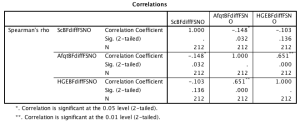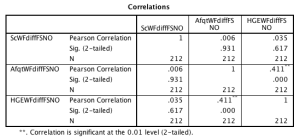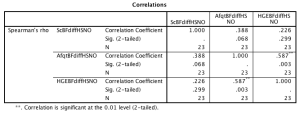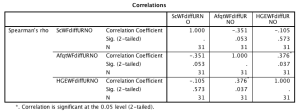Previously, we established that skin color and intelligence are correlated in the NLSY97 sample as predicted by hereditarian theory. Continuing this investigation, we looked into how these variables go together within and between African American families in the same sample. In other words, we wanted to know if lighter-skinned individuals tend to be smarter than their darker-skinned siblings just as the average light-skinned black in the general population is smarter than the average dark-skinned black.
The significance of this family study design is that hereditarian theory predicts that skin color will be substantially associated with IQ between families, but not within families. That is, if we have two African American siblings the darker one should be approximately as likely as the lighter one to be the smarter of the two. This is because skin color is controlled by a handful of genes, scattered across different chromosomes, and each (full biological) sibling is equally likely to inherit any variant. Skin color cannot be used as a proxy for ancestry when comparing siblings. (Possible linkage between “white” skin color alleles and “white” IQ alleles could cause skin color and IQ to be associated within families, too, but as skin color is controlled by a few large-effect genes and intelligence by perhaps hundreds of genes, each with tiny effects, any within-family effect would have to be extremely small.)
In the general African American population, genes for lighter skin and other “white” genes nevertheless tend to go together, with the best estimate for the correlation being rho=0.44 (Parra et al. 2004). The processes that can maintain this correlation are cross-assortative mating (lighter and whiter blacks tend to have children together) and continuous gene flow from the white population. This makes it possible to use skin color as a proxy for ancestry. Using a family design, we can also test if there are pleiotropic genes that influence both skin color and intelligence.
So, we investigated the associations between skin color (1=lightest, 10=darkest), IQ, and also educational attainment (=years of schooling completed) within and between African American families. The method used in our analyses was the one described in Jensen 1998, p. 139ff. In this method, the between-families correlation of variables X and Y is the correlation between the sums of the siblings’ scores in each sibling pair on X and the sums of the siblings’ scores in each pair on Y. The within-families correlation of variables X and Y is, in turn, the correlation between the signed difference between the siblings’ scores in each sibling pair on X and the signed difference between the siblings’ scores in each pair on Y. Therefore, the correlation between skin color and IQ within families is the correlation of sibling differences on IQ and skin color, while the between-families correlation is the correlation of the sums of sibling scores on the two variables (in our analyses, the sums are divided by two, so that the values are actually averages of the sibling scores).
Before getting into the nitty-gritty, I must give credit where it’s due. John and Meng Hu did all the heavy lifting in the following analyses, and I’m mostly just writing up and interpreting their results.
First, let’s look at the results from the between-families analysis of full biological siblings (N=212 pairs) using both Pearson and Spearman correlations (click for larger images):
The variables ScBFdiffFSNO, AfqtBFdiffFSNO, and HGEBFdiffFSNO represent the averages of each sibling pair’s skin color, IQ, and educational attainment scores, respectively. Between families, darker skin color is clearly associated with lower IQ. Darker skin color also predicts lower educational attainment. The correlation between IQ and educational attainment is rather large at 0.645.
The correlations between skin color and education are of the expected direction and magnitude but they are not significant at conventional levels. However, I’m fairly confident that this represents a real effect because of the results of the within-families analysis (see below) and because in the full non-sibling sample (N=1827) the correlations are similar (r=-0.091 and rho=-0.089) and highly significant.
Next, here are the results from the within-families analysis of full biological siblings (N=212 pairs), with Pearson and Spearman correlations shown:
ScWFdiffFSNO, AfqtWFdiffFSNO, and HGEWFdiffFSNO are variables representing differences between siblings in skin color, IQ, and educational attainment, respectively. As can be seen, skin color is completely unrelated to IQ and education between siblings. Darker-skinned individuals are as likely as their lighter-skinned siblings to have higher IQ and more education. This is not what the colorist hypothesis would have predicted, but it is in line with the hereditarian hypothesis.
IQ and education are correlated at r=0.410 and rho=0.362, which is expected because IQ differences are associated with educational achievement within families, too. However, the IQ-educational attainment correlation is higher between than within families (r=0.645 versus r=0.410). This might be due to shared family environments (e.g., individuals from wealthier families are more likely to go to college net of IQ) but also because siblings share genes for achievement-related non-cognitive traits such as conscientiousness. Range restriction could also have a small effect (see below).
The between-families correlation coefficients of skin color with IQ and educational attainment are around -0.15 and -0.10, while the within-families correlations are close to zero. This is pretty much what we predicted based on hereditarian assumptions. However, due to sample size limitations, the differences between the within- and between-families correlations do not quite reach statistical significance. (I’m not sure what statistical test should be used here, but this result seems unavoidable, given the small effect and sample sizes.)
Another caveat is that range restriction might have some attenuating effect on within-families correlations, but this effect must be small. Educational achievement and IQ certainly have substantial variability within families as can be seen from the fact that they have a moderately high intercorrelation.
While this analysis of course isn’t conclusive — more and larger samples are needed to obtain adequate statistical power — the within- and between-families results do suggest that skin color is not causally connected to IQ or educational attainment. Light skin color does not seem to cause higher IQ or educational achievement either through pleiotropy or because of color discrimination — otherwise the within-families correlations would have been similar to those obtained between families. Colorism, the theory that discrimination based on skin color is a major source of socioeconomic differences, appears to not apply within the African American population, at least as far as IQ and educational attainment are concerned.
What could then be the mechanism that gives rise to correlations between light skin color and positive outcomes in American blacks? There are two main possibilities. First, the correlations might be due to the fact that skin color is a proxy for white ancestry, including the better IQ genes that whites presumably have. Second, there might be cross-assortative mating for skin color and IQ, which could have, over generations, produced a genetic correlation between the two traits regardless of the fact that they are not functionally or causally related. The present data do not allow us to adjudicate between the two explanations, but I believe that both could be true to some extent. (See also here and here for evidence suggesting that cross-assortative mating cannot be the whole story.)
The family analysis can be further extended by considering half-siblings and step-siblings. Under hereditarian theory, it is expected that skin color might be, to a small degree, associated with IQ and educational attainment in half-siblings, unlike full siblings. Moreover, it is expected that the skin color associations between step-siblings (who are not biologically related) may be almost as high as the between-families correlations, depending on the degree of assortative mating. There are only a small number of black half- and step-siblings in the NLSY97, so the results cannot be very informative, but I’ll report them anyway because the variables are available (the meanings of the variable names below should be obvious from previous discussion).
Here are the Spearman correlations between and within families for half-siblings:
And the corresponding correlations for step-siblings:
While there’s a tendency towards predicted correlations, even some significant ones, I don’t think these very small half- and step-siblings sample can teach us much.
There are some samples other than the NLSY97 that may enable between and within family analyses of skin color effects. Perhaps we’ll tackle them at some point and also consider a wider range of outcome variables.
SPSS syntax for preparing NLSY97 data for within- and between-families analyses is available here. Note that the HGE* variables may contain illegitimate outliers (the valid range of values is -20 to +20) that must be excluded before analysis.
Discover more from Human Varieties
Subscribe to get the latest posts sent to your email.









“As can be seen, skin color is completely unrelated to IQ and education between siblings. Darker-skinned individuals are as likely as their lighter-skinned siblings to have higher IQ and more education. This is not what the colorist hypothesis would have predicted, but it is in line with the hereditarian hypothesis.”
I’m just highlighting the bottom line of your study here.
That’s worth knowing.
The reduced EDU x IQ within siblings is likely also due to the lower reliability of difference scores. I seem to recall reading somewhere that reliability is increased for composite or averaged scores (error cancels out); but for difference scores, the error compound, so reliability decreases. One could simulate data to see how it works in reality if one cannot work out the math.
So then the debate about the cause of the black-white IQ difference is over? If there is no substantial correlation between IQ and skin color within families, that proves that there is no oppressive environment that systemically discriminates and artificially suppresses the IQ of people with darker skin. That is it. Right? What’s the catch? Why isn’t this posted on Wikipedia? Why are there only 2 comments on this? If this is true, the hundred year old debate is over, and people should know about it.
The results have not been formally published. They will not be recognized until they are. I’ve been very sick. Would you be interested in helping writing them up? If not, you have your answer.